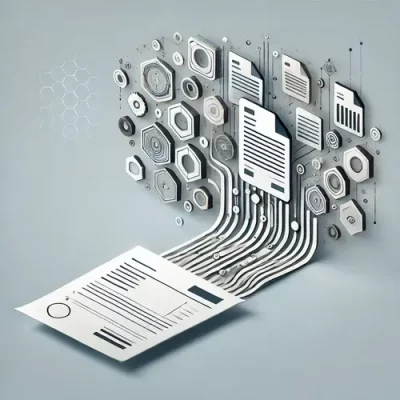Manually entering invoices into Zoho Books may be manageable when handling just a few, but as the volume increases, it quickly becomes overwhelming. Entering invoice details one by one is not only time-consuming but also increases the risk of errors that can disrupt your financial records.
To simplify the process, you can automate invoice imports instead of manually inputting data. Zoho Books supports bulk uploads, but the data must be properly formatted to prevent import errors and validation issues.
This guide will walk you through how to import invoices into Zoho Books efficiently, including how to convert PDF invoices into a CSV file that meets the platform’s formatting requirements.
Step 0: Digitalize Invoices (For Paper Invoices)
If you have paper documents, the first step is to scan the invoices into a digital format. A high-resolution PDF ensures better data extraction accuracy and reduces processing errors.
To get the best results, keep the document clean, remove unnecessary marks, and align it properly to avoid skewed text. Using a high-resolution scan enhances text recognition, making it easier to extract data when converting PDFs to CSV files for Zoho Books
Step 1: Capture Invoice Data
DocuClipper automates the extraction of invoice data, eliminating the need for manual entry. Instead of typing invoice details line by line, you can instantly capture key information such as vendor name, invoice number, invoice date, line items, amounts, tax, and quantities.
Automatic Invoice Data Capture with DocuClipper
DocuClipper simplifies invoice data extraction by automatically extracting data, like vendor name, invoice number, invoice date, line items, amounts, tax, and quantities. Instead of manually typing or copying the invoice information, all data is processed digitally.
How to use DocuClipper:
- Open DocuClipper in your web browser and go to the invoice OCR section.
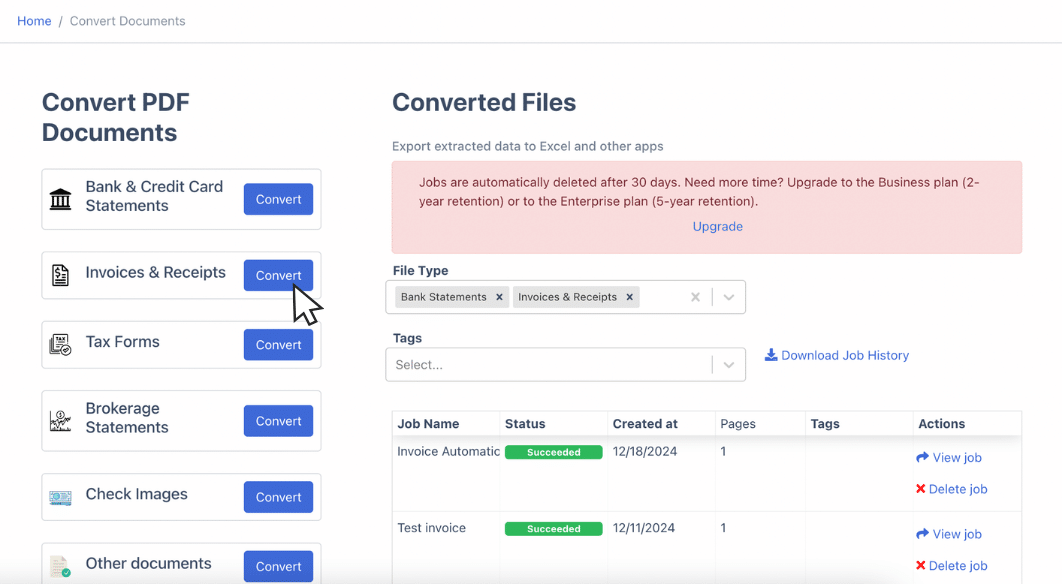
- Drag and drop one or multiple invoices.
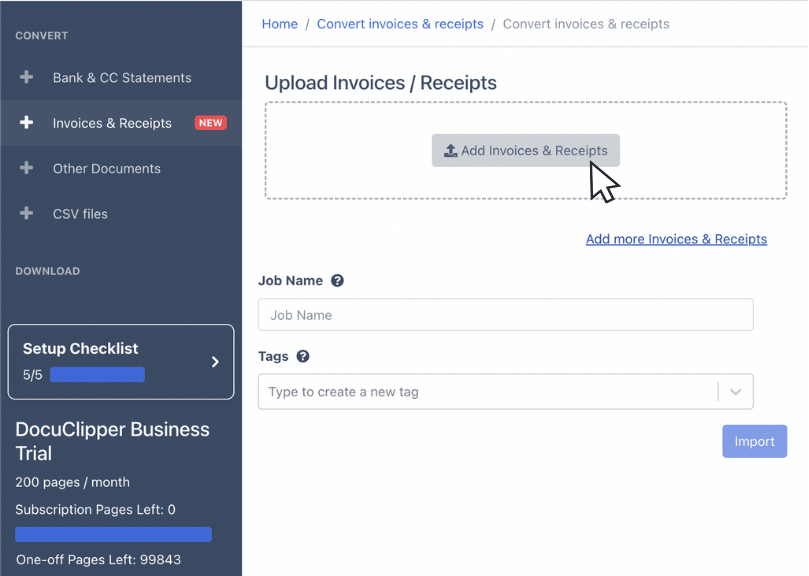
- DocuClipper extracts the invoice data from PDFs automatically, no need to manually parse the sections of the invoices, this applies to all invoice formats.
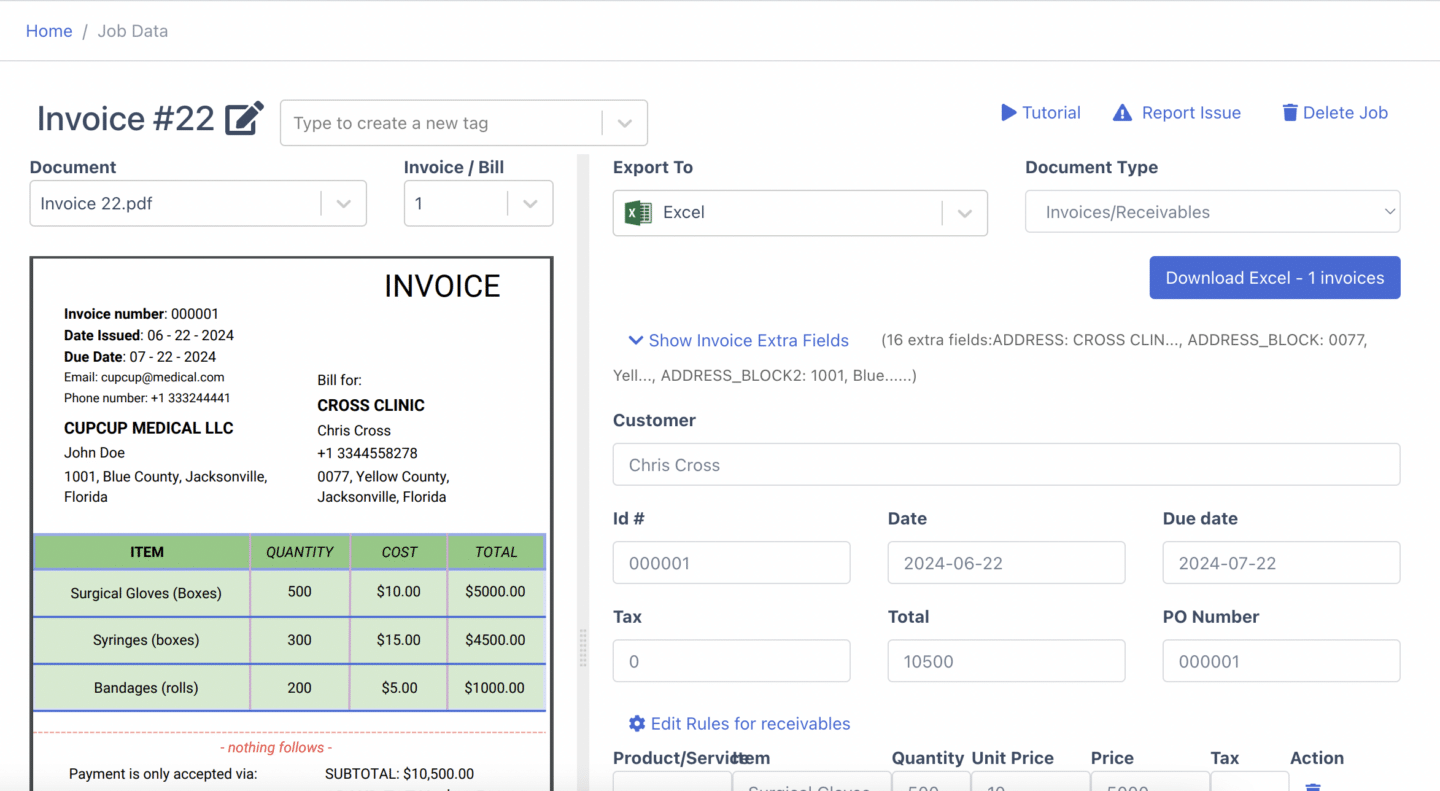
- Review the extracted line item information and adjust fields if needed, including marking transactions as invoices, bills, accounts payable, or accounts receivable.
After the process, DocuClipper will make a Zoho Books-compatible CSV file that meets all formatting requirements.
The Manual Alternative (Not Recommended)
If you opt for manual data entry, you’ll need to create a spreadsheet, input vendor details, invoice numbers, amounts, and tax information, and then structure it according to Zoho Books’ import format before saving it as a CSV file.
This method is inefficient, prone to mistakes, and time-consuming. Even with careful verification, manual entry has an estimated 4% error rate, increasing the risk of financial discrepancies. Processing a single invoice can take up to 30 minutes, making it impractical for businesses handling large invoice volumes.
By using DocuClipper, you can automate data capture, reduce errors, and ensure your invoices are accurately formatted for seamless import into Zoho Books.
Step 2: Export the Invoice Data Into Zoho Books Compatible CSV File
DocuClipper simplifies the process of exporting invoice data into a format that Zoho Books can process. Once the invoice details have been captured and verified, the next step is to generate a properly formatted CSV file.
After uploading and reviewing the invoice data in DocuClipper, navigate to the export section and choose CSV as the export format.
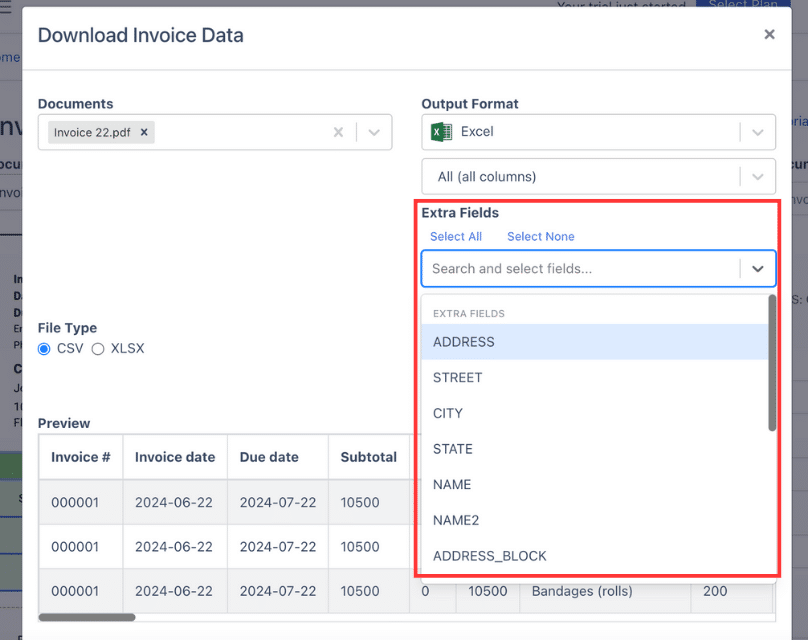
If necessary, modify the column arrangement to align with Zoho Books’ formatting requirements. Once everything is in order, download the finalized CSV file.
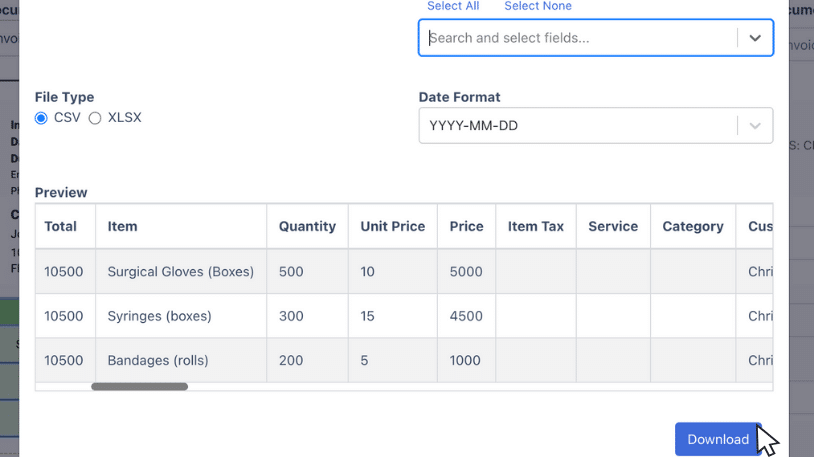
Since Zoho Books has specific import guidelines, it’s essential to double-check the spreadsheet before proceeding. Ensure that all required fields are accurately labeled and structured to prevent any issues during the import process.
Step 3: Import Invoice Data Into Zoho Books
Once your CSV file is ready, the next step is to import it into Zoho Books. The platform allows bulk invoice uploads, making it easy to process multiple invoices without manual entry.
1. Open the Invoice Import Tool
Log in to Zoho Books and navigate to Sales > Invoices. Click on the More Actions (three dots) button and select Import Invoices from the dropdown menu.
2. Upload the CSV File
Click Choose File and select the CSV file exported from DocuClipper. If the file is in Excel format, convert it to CSV before proceeding.
3. Set Import Preferences
- Choose whether you want Zoho Books to generate invoice numbers automatically or use the ones in your CSV file.
- If your file contains multiple line items per invoice, ensure that each line has the same invoice number, date, and customer name so they are grouped correctly.
- Select the correct Character Encoding and Delimiter (usually Comma) to match the file format.
4. Map Fields to Zoho Books Format
Zoho Books will attempt to match the columns in your CSV file with its required fields. Review the mappings and adjust any incorrect matches before proceeding.
- Required fields: Customer Name, Invoice Date, Invoice Number, and Item Price.
- If you regularly import invoices using the same format, you can save the field mapping settings for future imports.
5. Start the Import Process
Click Next to begin the import. Zoho Books will validate the data and highlight any errors, allowing you to correct them before completing the import.
6. Verify Imported Invoices
Once the import is complete, navigate to Sales > Invoices to review the newly imported invoices. Open a few invoices to ensure that all details, including amounts, line items, and taxes, have been imported correctly.
- How to Import invoices into QuickBooks Online
- How to Import Invoices into Dynamics 365 Business Central
- How to Import Invoices into SAP Business One
- How to Import Invoices into Xero
- How to Import Invoices into Sage
- How to Import Invoices into NetSuite
How DocuClipper Automates Importing Invoices Into Zoho Books
Manually entering invoice data into Zoho Books is time-consuming, prone to errors, and inefficient, especially when processing a large volume of invoices.
Instead of spending hours inputting details manually, DocuClipper automates the process by extracting invoice data and converting it into a Zoho Books-compatible CSV file in seconds.
With DocuClipper, you can handle multiple invoices at once, capturing key details such as invoice numbers, dates, vendor names, line items, and totals with precision. The generated CSV file is fully customizable, ensuring it aligns with Zoho Books’ import requirements without additional manual formatting.
If you prefer working with spreadsheets, DocuClipper also enables you to convert PDF invoices into Excel. Its advanced OCR technology enhances accuracy, reducing typos and data entry errors, so your invoices are imported correctly the first time.
FAQs about Importing Invoices into Zoho Books
Here are some frequently asked questions about how to import invoices into Zoho Books:
How do I bulk import invoices into Zoho Books?
To bulk import invoices into Zoho Books, go to the Invoices section, click the three-dot menu, and select Import Invoices. Upload your CSV file, ensure the columns match Zoho Books’ required fields, and proceed with the import. If needed, Zoho Books can auto-generate invoice numbers. Review the imported data before finalizing.
Can I import a CSV file into Zoho Books?
Yes, you can import a CSV file into Zoho Books. Go to the Invoices section, select Import Invoices, and upload your CSV file. Ensure your columns match Zoho Books’ required fields. After mapping the data correctly, proceed with the import. Review the imported records to confirm accuracy before finalizing.
Can I import transactions into Zoho Books?
Yes, you can import transactions into Zoho Books using a CSV file. Navigate to the Transactions section, select Import, and upload your file. Ensure the data is mapped correctly to Zoho Books’ fields. Once imported, review the records for accuracy. This process works for invoices, expenses, payments, and other financial transactions.
Can you import old data into Zoho Books?
Yes, you can import old data into Zoho Books using a CSV file. Go to Settings > Data Backup & Import, choose the module, and upload your file. Ensure the fields match Zoho Books’ format. This allows you to migrate historical invoices, expenses, and transactions for accurate record-keeping and financial reporting.
Can you import a bill into Zoho Books?
Yes, you can import bills into Zoho Books using a CSV file. Go to the Bills section, select Import Bills, and upload your file. Ensure the data fields match Zoho Books’ required format. After mapping the columns correctly, proceed with the import. Review the imported bills for accuracy before finalizing the process.
Can I import Excel into Zoho Books?
Yes, you can import Excel files into Zoho Books by converting them to CSV format. Go to the Import section, select the module, and upload your file. Ensure the columns are mapped correctly to Zoho Books’ fields. Once imported, review the data for accuracy before finalizing to ensure smooth financial record-keeping.
